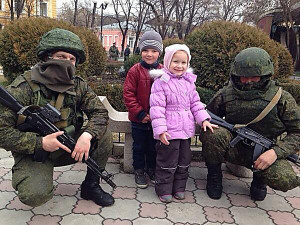
The United States alone has hundreds of military bases around the world, has been permanently occupying Germany and Japan for a half century, Afghanistan for over a decade, and had invaded and occupied Iraq for nearly as long.
“Russian Aggression” is a Marketing Gimmick
Canadian PM Stephan Harper’s “op-ed” in the Globe and Mail titled, “Our duty is to stand firm in the face of Russian aggression,” fallaciously states:
The world is saddened and rightfully outraged by images of the charred remnants of Malaysia Airlines Flight MH17, and by the loss of almost 300 people from 11 countries, strewn across fields in eastern Ukraine. While the grim work of identifying victims’ remains and tracking down the perpetrators of this appalling crime is just beginning, the world can be certain of one thing: There can be no weakening of our resolve to punish the Putin regime for threatening the peace and security of eastern and central Europe.
Harper’s disingenuous attempt to link Russia to the MH17 disaster reveals the truth behind “Russian aggression,” a marketing campaign implemented by the West to undermine an obstruction to its very real, very demonstrable global aggression. The fact that Harper presides over the nation of Canada, which is in no way threatened by “Russian aggression” real or imagined, further exposes the disingenuous nature of the narrative peddled by the West.
Aggressors Playing the Victim – From Hitler to NATO

In fact, the Guardian would admit in its 2004 article, “US campaign behind the turmoil in Kiev,” that (emphasis added):
…while the gains of the orange-bedecked “chestnut revolution” are Ukraine’s, the campaign is an American creation, a sophisticated and brilliantly conceived exercise in western branding and mass marketing that, in four countries in four years, has been used to try to salvage rigged elections and topple unsavoury regimes.
Funded and organised by the US government, deploying US consultancies, pollsters, diplomats, the two big American parties and US non-government organisations, the campaign was first used in Europe in Belgrade in 2000 to beat Slobodan Milosevic at the ballot box.
Richard Miles, the US ambassador in Belgrade, played a key role. And by last year, as US ambassador in Tbilisi, he repeated the trick in Georgia, coaching Mikhail Saakashvili in how to bring down Eduard Shevardnadze.
Ten months after the success in Belgrade, the US ambassador in Minsk, Michael Kozak, a veteran of similar operations in central America, notably in Nicaragua, organised a near identical campaign to try to defeat the Belarus hardman, Alexander Lukashenko.
That one failed. “There will be no Kostunica in Belarus,” the Belarus president declared, referring to the victory in Belgrade.
But experience gained in Serbia, Georgia and Belarus has been invaluable in plotting to beat the regime of Leonid Kuchma in Kiev.
The operation – engineering democracy through the ballot box and civil disobedience – is now so slick that the methods have matured into a template for winning other people’s elections.
In other words, from Belarus, to Georgia, to Ukraine, and Serbia, the US has been insidiously overthrowing governments not through outright military aggression, but through covert military, political, and intelligence operations aimed at manipulating elections and overrunning regimes that refuse to accept the subsequently skewed results. Surely, then, regimes resulting from such a practice are not then “voluntarily” joining NATO – and NATO is surely expanding itself through a campaign of insidious, violent, lawless subversion of sovereign nations, one at a time with Ukraine once again in its sights.
Nazis At the Gates (Again)
The parallels between NATO and Nazi Germany are unfortunately more than merely academic. In Ukraine, the current regime in Kiev backed by NATO and the European Union are quite literally Nazis. From the “Fatherland Party” to the overtly Neo-Nazi Svoboda Party and their various militant wings including the now notorious Right Sector front, ultra-right fascism is once again the leading edge of expansionism into, not out of, Russian territory.
Current attempts by the West to portray Russia’s concern over Ukraine and the Nazi menace festering on their doorstep to Soviet leader Josef Stalin’s invasion of Poland aim to stir up anti-Communist, anti-Soviet fears and hysteria long programmed into the psyches of Western audiences – but incidentally provide a valuable historical parallel. While the invasion of Poland was a violation of Polish national sovereignty and an act of war – it was done to create a barrier between the Soviet Union and the rise of Nazi Germany under Adolf Hitler. Such a barrier was arguably one of several factors that allowed the Soviets to mobilize a counteroffensive to Hitler’s Operation Barbarossa – the invasion of Russia, a counteroffensive that ultimately turned the tide against Hitler and led to the downfall of fascism in Europe.
Besides cause and effect, there are few other similarities between Stalin’s invasion of Poland and the modern day Russian Federation’s political support of eastern Ukrainians who have been fighting the regime in Kiev for months with increasing success. Besides the same variety of dubious accounts the West fabricated against nations like Iraq, Libya, and Syria as a pretext for war, little in terms of evidence has been produced by Washington, London, or Brussels to affirm accusations that Russia is “invading” eastern Ukraine. Russia has instead chosen restraint despite multiple attempts by the West to bait it into overt military intervention in Ukraine – and in this restraint, has secured a growing global consensus long driven weary by the West’s attempts to dress up its own global aggression and expansionism as “democracy promotion” and “humanitarian interventions.”
Tony Cartalucci, Bangkok-based geopolitical researcher and writer, especially for the online magazine “New Eastern Outlook”.
